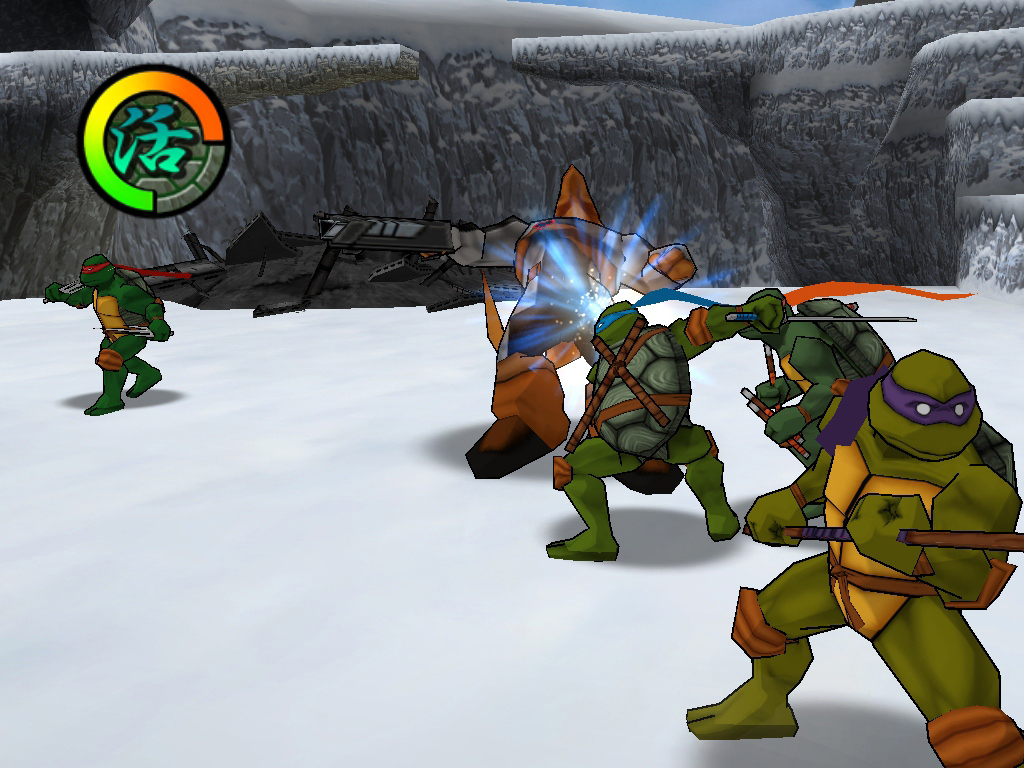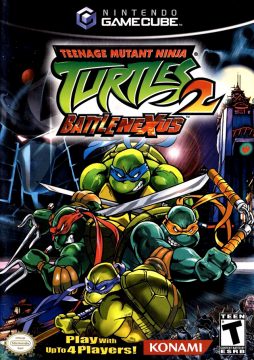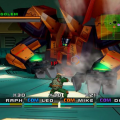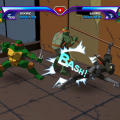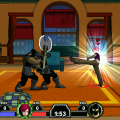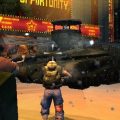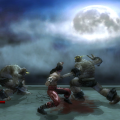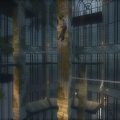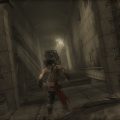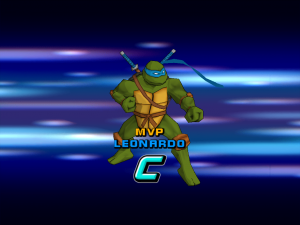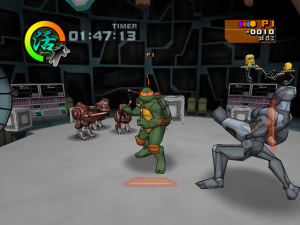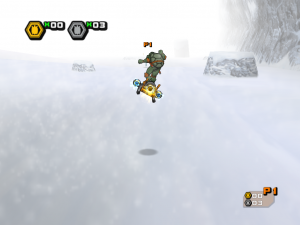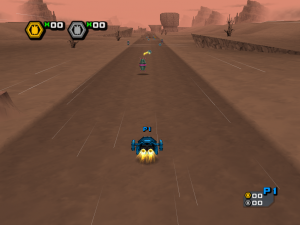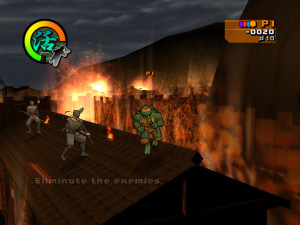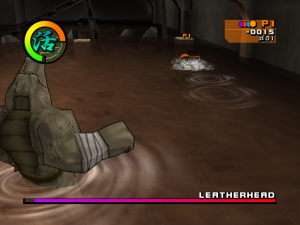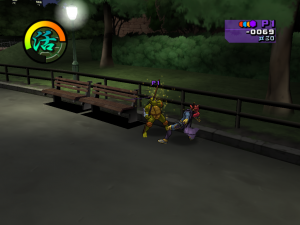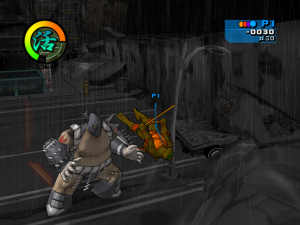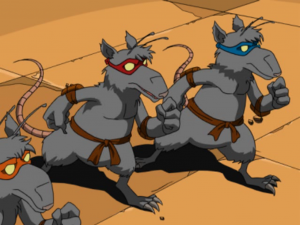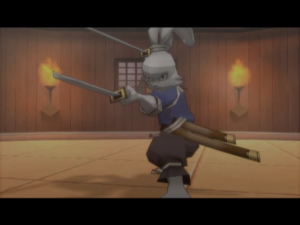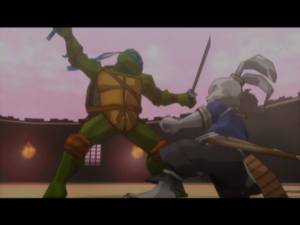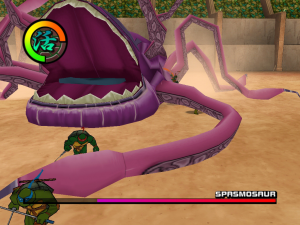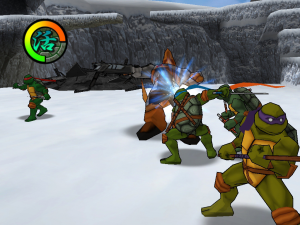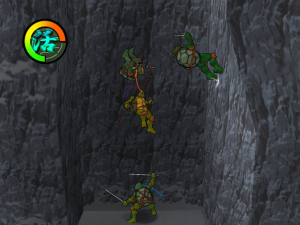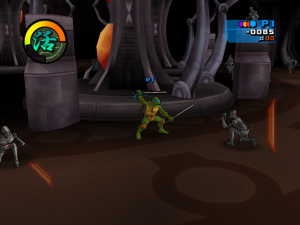- Teenage Mutant Ninja Turtles (NES)
- Teenage Mutant Ninja Turtles: The Arcade Game
- Teenage Mutant Ninja Turtles: World Tour
- Teenage Mutant Ninja Turtles: The Manhattan Missions
- Teenage Mutant Ninja Turtles III: The Manhattan Project
- Teenage Mutant Ninja Turtles: Turtles in Time
- Teenage Mutant Ninja Turtles: Hyperstone Heist
- Teenage Mutant Ninja Turtles: Fall of The Foot Clan
- Teenage Mutant Ninja Turtles II: Back From The Sewers
- Teenage Mutant Ninja Turtles III: Radical Rescue
- Teenage Mutant Ninja Turtles: Tournament Fighters (Genesis)
- Teenage Mutant Ninja Turtles: Tournament Fighters (SNES)
- Teenage Mutant Ninja Turtles: Tournament Fighters (NES)
- Teenage Mutant Ninja Turtles (Console – 2003)
- Teenage Mutant Ninja Turtles (GBA – 2003)
- Teenage Mutant Ninja Turtles 2: Battle Nexus (Consoles)
- Teenage Mutant Ninja Turtles 2: Battle Nexus (GBA)
- Teenage Mutant Ninja Turtles: Mutant Melee
- Teenage Mutant Ninja Turtles 3: Mutant Nightmare (Console)
- TMNT (2007) – Console
- TMNT (2007) – NDS and PSP
- Teenage Mutant Ninja Turtles 3: Mutant Nightmare (DS)
- TMNT (GBA)
- Teenage Mutant Ninja Turtles: Smash-Up
- Teenage Mutant Ninja Turtles: Arcade Attack
- Teenage Mutant Ninja Turtle (Plug and Play)
- Teenage Mutant Ninja Turtles Fast Forward: Ninja Training NYC / TMNT: Power of 4
- TMNT: Ninja Adventures – Mini-Game and Activity Centre
- Teenage Mutant Ninja Turtles: The Ninja Tribunal / The Shredder Reborn
- Teenage Mutant Ninja Turtles: Double Damage
One year after the release of the reboot game series, the next chapter in the 3D brawler series was ready to hit the scene, promising to deliver more of everything that was seen in the first title, and also provide a truly innovative multiplayer experience worthy of the TMNT name. The premise of the game revolves around the Battle Nexus, a multiple-dimension-spanning tournament, a storyline which has appeared in many of the different TMNT iterations over the year.
The big emphasis in Battle Nexus is co-op gameplay between all four turtles at the same time, a staple to the old arcade games but somewhat forgotten as years had gone by. The major complaints over the prior title mostly revolved around the fact that, despite drawing a lot of inspiration from the classic arcade games, TMNT 2k3 only allowed for two players simultaneously. In Battle Nexus, the entire game bases itself on the idea that each of the brothers’ individual skills to overcome all the obstacles presented along their path. Leonardo’s katanas can be used to cut bamboo to open new pathways, Mike can use his spinning nunchuks to glide through the air to cover great distances, Don can operate electronic equipment and Raph can push heavy obstacles out of the way. All these skills is in some way or another put into use through the 40-plus levels to pave the way and to uncover secrets. The single player or two player alternative allows for hot swapping on the fly to make use of all the turtles.
Unlike its predecessor which took place over a set path divided into episodic levels, Battle Nexus now offers a map system with a central station hub that acts as the headquarters. Beating one level opens the next, and many levels have multiple paths which will open up new sections to the map and lead the adventure in a different direction. Each level is also given an animated prelude and aftermath which attempt to bridge the entire season’s story and the exclusive new sections together to tell the very large arc of the Battle Nexus storyline. Each stage is constructed large in the same style as the previous game, being short interactive battlegrounds with some exploration for the secrets and pathways. New to Battle Nexus are the surfing levels, where the Ninja Turtles board either hovercrafts of space ships and blaze through territory at breakneck speed, picking up tokens and avoiding dangers, much in the style of the surfing stages found in Turtles in Time. At the end of each section of the map, which expands into time and space, there are also boss stages at the very end. The world map allows for some non-linear progression depending on which path is chosen to complete certain stages.
Apart from the special skills, the characters themselves control differently. Initially the moveset is very limited, with their skills requiring some tuning and powerups in order to broaden further. Each turtle also have a very notable speed difference between each of them, and the timing required to trigger the combos changes. Due to the increase of navigation and platforming sections to the stages, a new double jump is also introduced, along with the possibility to lifting items or characters and throwing them. There is also an all new dash move that quickly stuns the opponent, and the charge move which acts as a Mana style charge special which inflicts great damage to any opponent. Each character has very different types of strikes and charge special, requiring some strategic selection to which turtle is sent into boss battles.
The most important item to be found are the four crystals, each acting as both a temporary powerup during the stage and as an upgrade item that increases skills permanently. For the crystals, Blue is for infinite shurikens and capacity abilities, Red is for increased strength and additional moves and combos, Green is for defense and counter abilities and Orange is for instant charge and increased charge powers. After each stage the amount of items is tallied up and displayed on the ranking screen, and once a certain number has been reached, skills are upgraded with an explanation shown of how to execute the new skills. For stages such as the surfing levels, silver and golden tokens must be picked up to reach a high score in order to be awarded crystals. Each stage also holds a hidden artifact, which can be viewed in April’s antique store to unlock further secrets, costumes and other pieces of trivia and interest. Each stage also serves a buffet of edible health refills such as pizzas and colored sugar drinks.
Graphically the game refines the cel shaded style even further to bring the game’s aesthetics even closer to the look for the cartoon show, and the polygon count is increased for better anatomy and smoother shapes. Even up close, each character look incredible, even doing away with the crude sharpie style faces and adding some real nice detail and coloring the entire look, head to toe. Battle Nexus also sports a much improved enemy roster, bringing the Utroms, Triceratons, Foots, Purple Dragons and bio engineered mutants into the action to what is by far the largest cast of TMNT characters assembled in one single game. Battle Nexus also runs at a constant 60 frames per second, even during four player action.
But beyond the graphical improvement, Battle Nexus hoverboards itself right off the cliff in a dramatic fashion. Very little else has been given the attention it needs, and the new features are all woefully thin and neglected. The game injects pure venom into the veins by falling short on nearly every single aspect in its gameplay, and the focus on multiplayer and variety in the Ninja Turtles actually ends up damaging the game to an alarming extent when it very much is the center point and main selling point which, as one can just imagine, makes quite a large impact on the overall experience. The stage design is what manages to break the multiplayer aspect entirely, not by chaotic mayhem or uncontrollable camera systems, but rather through complete indifference. Despite the wealthy number of levels, an impressive amount of zero levels actually makes use of any cooperation between the characters, and there are no teamup moves to be found whatsoever. In fact each level does make use of more platforming sections than the previous title, but these consists of making precise jumps to make it onto a moving platform or conveyer belts (and man does this game have more conveyer belts than Little Lisa’s Recycle Plant), but this is hardly the form of adventuring that suits up to four players, which inevitably is going to come to include someone who just can’t get the hang of the game and miss the jump over and over. One might start thinking that this is fine because eventually that person is gonna run out of energy and the rest can continue on, but this turtle soup is spiced differently. You see, all characters share a life bar. Yes, if one player dies, everyone dies.
The level design and the enemy AI, which admittedly was quite bland and lacking in the first game, takes a bare knuckle punch to the gut as well. While the first game made the limitations works better within its smaller framing and linear style, Battle Nexus presents itself as a large reaching adventure spanning galaxies and time periods, yet both the AI and the overall layout of each stage remains planted in its most primitive form. The game also seems to have been made in sequence, as it gets progressively worse and unlockable design sketches for the stages begin to show signs of being rushed to completion. Another glaring issue is the fact that each stage rarely lasts longer than 30-60 seconds, being just short intervals between the many cutscenes found in the game. Some stages actually feature a longer combined running time of cutscenes than combined length of gameplay, an issue most associated with Konami’s blockbuster Metal Gear Solid. And though some of the cutscenes are fairly entertaining, they are inconsistent in presentation and animation style, with some being directly taken from the season two episodes, other animated exclusively for the game (albeit at a much lower quality than the first game) and also CGI cutscenes, none which blend very well and feature very different style of photography and pace. Not only do the cutscenes struggle with artistic consistency, they can also create a whole mess of continuity due to the fact that several stages has more than one path, leading to stages being done out of sequence, and therefore cutscenes being played out of order.
Likewise, the new combo and battle system actually goes backwards. In giving each turtle a different feel and pace, requiring very particular timing, the individual movesets are brought down to about four different moves, unlockables included. To begin with, it might even feel as if the game is broken due to the choppy way the short combos abruptly ends, and it takes a good two quarters of the game in order to efficiently upgrade the arsenal to feel any substantial difference. Worse yet is that Battle Nexus, in attempting to create some strategic elements to the battle system, gives the enemies a wider range of attack than the actual turtles themselves, stating that players needs to figure out the best course of action by choosing the right turtle for the job. A noble idea, though immediately disregarded due to the fact that none of the characters have a large enough list of commands to effectively fight fairly, leading to each battle basically becoming a single button mash to perform a corner trapping double hit combo until the foe is defeated. Even with the many bosses in the game, the only true strategy that works is to trap them in the corner and spam a single attack.
One area that can’t be faulted is the sheer amount of content packed into the game however. Each stage holds a plethora of unlockables, all which are presented with rich visual and descriptive representation. Anything from statues to characters and gadgets can be examined at April’s store, and each item unlocking a piece of art or codes to input for powerups or other tools of aid for the Turtles. Familiar faces such as Splinter and Casey Jones can be unlocked as playable characters.
In addition to costumes and characters, new gameplay modes can also be unlocked, namely the actual Battle Nexus mode. Serving as a gauntlet style survival mode, Battle Nexus allows for a 10 round back to back battle with several enemies and bosses to unlock new antiques and crystals which one turtle must endure, only awarded a selection of breakable crates between each round which may contain either shurikens or health refills. Perhaps Battle Nexus‘s greatest claim to fame can be said to be found in this mode. At the end of the tournament, Stan Sakai’s iconic rabbit ronin, Usagi Yojimbo, makes a surprise cameo, appearing in a video game for the first time since 1988, and for the very first time in 3D. Sadly, Usagi does not appear as an unlockable character.
But what Battle Nexus is ironically most remembered for is the ability to unlock The Arcade Game, the 1989 classic in all its arcade glory. As noted in earlier in this article, this port brings a number of changes, changing out the imagery and sounds taken from the 1987 cartoon with the new 2k3 version, and the soundtrack being a synthesized downscaled version of the Battle Nexus soundtrack. The fact that the game in its entirety is included is a pretty neat feature on behalf of Konami, and even with the changes made, it holds up remarkably well, much better than the game it is found within.
Beyond the slick graphics and numerous unlockables, there is very little substance to be found, and the highly convoluted story only serves to overcomplicate a game that cannot even get comfortable with its simplistic outline. It wouldn’t be so bad if the team simply focused more on actually making the game a multiplayer experience rather than adding multiplayer to a preexisting single player experience, and making no effort whatsoever to make use of their individual skills in any puzzle or obstacle. When released, the game was universally panned, and quite rightfully so, being to date the lowest rated TMNT game ever released. Despite this, the game sold exceptionally well due to the popularity of TMNT toy merchandising and the lure of the unlockable arcade game.
As with the first 3D game, Battle Nexus was released on all sixth generation consoles in identical versions, with the only difference being that the PlayStation 2 required a multitap in order to enjoy the full experience of The Arcade Game, and suffering from some framerate drops. The PC version seems to be a hasty port of the Xbox game, allowing for higher resolution, but surprisingly omitting the inclusion of the classic arcade game. The artifact itself can be found and inspected at April’s shop, but doing this does not trigger the game to become unlockable as in the console version.
A piece of often overlooked trivia about this game is the fact that during the battle with the Utroms, Battle Nexus actually takes place in the very same room depicted in Michael Dooney’s cover for the fourth issue of TMNT, which was used as the cover for the NES game.
